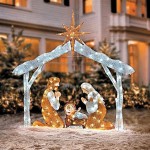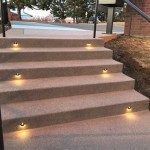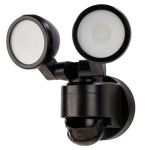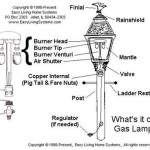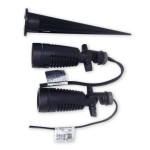Outdoor Motion Sensor Light Parts: A Comprehensive Guide
Outdoor motion sensor lights provide security and convenience by automatically illuminating an area when movement is detected. These lights are comprised of several key components that work in unison to ensure proper function. Understanding the individual parts and their respective roles is crucial for maintenance, troubleshooting, and selecting the appropriate motion sensor light for specific needs. This article offers a detailed exploration of the various parts of an outdoor motion sensor light, explaining their function and significance.
The Motion Sensor: The Core of the System
The motion sensor, often referred to as a passive infrared (PIR) sensor, constitutes the central element of the motion-activated lighting system. This sensor does not emit any energy itself; instead, it detects infrared radiation emitted by objects in its field of view. All objects with a temperature above absolute zero emit infrared radiation, and the sensor is calibrated to detect changes in this radiation, specifically when a warm object, such as a person or animal, moves across its field of view.
PIR sensors typically consist of two pyroelectric sensors arranged side by side. These sensors are sensitive to changes in infrared radiation. When both sensors detect the same amount of infrared radiation, the sensor remains inactive. However, when one sensor detects significantly more or less infrared radiation than the other, it indicates a change in the environment, and the sensor triggers the lighting circuit. The sensitivity of the sensor is generally adjustable, allowing users to customize the range and responsiveness of the light.
The field of view of the motion sensor is a critical factor determining its effectiveness. The field of view is the area within which the sensor can detect movement. This is usually specified in degrees, such as 180 degrees or 270 degrees. A wider field of view allows the sensor to detect movement from a broader area. However, a wider field of view may also increase the likelihood of false triggers, such as from swaying trees or passing cars. The optimal field of view depends on the specific application and the surrounding environment.
The range of the motion sensor is another important consideration. This refers to the maximum distance at which the sensor can detect movement. The range is typically specified in feet or meters. A longer range allows the sensor to detect movement from further away, providing earlier warning of potential security threats. However, a longer range may also increase the likelihood of false triggers. Again, the optimal range depends on the specific application and the surrounding environment.
Some advanced motion sensors incorporate features such as adjustable sensitivity, detection zones, and pet immunity. Adjustable sensitivity allows users to fine-tune the sensor's responsiveness to minimize false triggers. Detection zones allow users to mask certain areas from triggering the sensor, preventing activation by irrelevant movements. Pet immunity employs algorithms to differentiate between the heat signatures of humans and animals, reducing the likelihood of the light being triggered by pets.
The Light Fixture: Housing and Illumination
The light fixture serves as the housing for the light bulb and provides the necessary electrical connections. The fixture is typically made of durable materials such as metal or plastic to withstand outdoor conditions. The design of the fixture plays a crucial role in the overall aesthetics and functionality of the lighting system.
The type of light bulb used in the fixture is a significant factor in determining the brightness, energy efficiency, and lifespan of the light. Common types of light bulbs used in outdoor motion sensor lights include incandescent, halogen, compact fluorescent (CFL), and light-emitting diode (LED) bulbs. LED bulbs are increasingly popular due to their high energy efficiency, long lifespan, and instant-on capability.
The light fixture includes a reflector, which is a polished surface designed to redirect light from the bulb and focus it in a specific direction. The reflector's shape and material significantly impact the light's distribution and intensity. Well-designed reflectors can maximize the light output and ensure that the light is directed where it is needed most.
Many outdoor light fixtures are designed to be weatherproof, protecting the electrical components from rain, snow, and other environmental elements. Weatherproof fixtures typically have sealed enclosures and gaskets to prevent water ingress. The Ingress Protection (IP) rating indicates the degree of protection provided by the enclosure. A higher IP rating indicates a greater level of protection.
The light fixture also includes a lens or cover, which protects the light bulb and diffuses the light. The lens is typically made of glass or plastic. Some lenses are designed to be shatter-resistant to prevent damage from impacts. The lens can also be tinted or frosted to modify the color or intensity of the light.
The Control Circuitry: Regulating the Light's Operation
The control circuitry is responsible for processing the signals from the motion sensor and controlling the activation of the light. This circuitry typically includes a timer, a relay, and various electronic components that work together to regulate the light's operation.
The timer controls the duration for which the light remains illuminated after motion is detected. This duration is typically adjustable, allowing users to customize the light's behavior to suit their needs. The timer prevents the light from remaining on indefinitely after motion has ceased, conserving energy and reducing light pollution.
The relay acts as an electronic switch, controlling the flow of electricity to the light bulb. When the motion sensor detects movement, it sends a signal to the control circuitry, which then activates the relay. The relay closes the circuit, allowing electricity to flow to the light bulb and illuminate the area. When the timer expires, the relay opens the circuit, turning off the light.
The control circuitry also includes various electronic components, such as resistors, capacitors, and transistors, which perform specific functions within the circuit. These components ensure that the light operates correctly and reliably. The quality and reliability of these components are crucial to the overall performance and lifespan of the motion sensor light.
Some advanced motion sensor lights incorporate microcontrollers or microprocessors in their control circuitry. These advanced components allow for more sophisticated control and features, such as adjustable sensitivity, detection zones, and pet immunity. Microcontrollers can also be programmed to implement custom lighting schedules or integrate with other smart home devices.
The Power Supply: Providing Electricity
The power supply provides the electrical energy required to operate the motion sensor light. This typically involves connecting the light to the household electrical grid, either directly or through a transformer. The power supply must provide the correct voltage and current to ensure that the light operates safely and efficiently.
Most outdoor motion sensor lights are designed to operate on standard household voltage, such as 120 volts in North America or 230 volts in Europe. Some lights may require a transformer to step down the voltage from the household supply to a lower voltage, such as 12 volts or 24 volts. These lower voltage lights are often used in situations where safety is a concern, such as near water features.
The power supply includes a fuse or circuit breaker to protect the light from overcurrents. An overcurrent occurs when the electrical current exceeds the safe limit, potentially damaging the light or causing a fire. The fuse or circuit breaker is designed to interrupt the flow of electricity in the event of an overcurrent, preventing damage.
The wiring connecting the light to the power supply must be properly insulated and protected from the elements. Outdoor wiring is typically encased in conduit or buried underground to prevent damage from moisture, sunlight, and physical impacts. Improperly installed wiring can pose a serious safety hazard.
Some motion sensor lights are powered by batteries, typically used in locations where access to the electrical grid is limited or unavailable. Battery-powered lights offer greater flexibility in placement but require periodic battery replacement or recharging. The lifespan of the batteries depends on the type of battery, the usage frequency, and the brightness of the light.
Mounting Hardware: Securing the Light
The mounting hardware is used to securely attach the motion sensor light to a wall, ceiling, or other surface. The mounting hardware must be strong and durable enough to support the weight of the light and withstand wind, rain, and other environmental forces.
The mounting hardware typically includes screws, bolts, brackets, and other fasteners. The specific type of mounting hardware required depends on the type of light and the surface to which it is being attached. It is important to use the correct type of mounting hardware to ensure that the light is securely attached and does not pose a safety hazard.
When mounting the light to a wall, it is important to ensure that the wall is strong enough to support the weight of the light. If the wall is made of drywall or plaster, it may be necessary to use anchors to provide additional support. Anchors are designed to distribute the weight of the light over a larger area, preventing the screws from pulling out of the wall.
When mounting the light to a ceiling, it is important to ensure that the ceiling is strong enough to support the weight of the light. If the ceiling is made of drywall or plaster, it may be necessary to use ceiling joists to provide additional support. Ceiling joists are structural members that run horizontally across the ceiling, providing a solid foundation for the light.
The mounting hardware should be made of corrosion-resistant materials, such as stainless steel or aluminum, to prevent rust and ensure long-term durability. Corrosion can weaken the mounting hardware, potentially causing the light to fall and creating a safety hazard.

Lepro Motion Sensor Outdoor Light Led Security Flood Lights With 3 Adjustable Heads 270 Wide Lighting Angle 27w 3200lm Super Bright Ip65 Waterproof For Yard Porch Garage Black Com

Dualux Broe Motion Sensor Dusk To Dawn Outdoor Security Flood Light 180 Degree Range 70 Ft T0695 The Home Depot

Dualux Broe Motion Sensor Dusk To Dawn Outdoor Security Flood Light 2 Adjustable Heads 4 Modes T0693 The Home Depot

York Textured Pewter Motion Sensor Dusk To Dawn Traditional Outdoor Wall Light With Clear Glass Com

The Best Outdoor Motion Sensor Lights In 2024 Popular Science

Parts Solar Light Human Sensor Garden Wall Sconce Ground Plug Lighting Small Floor Lamp

Motion Light Sensor Adapters At Com

Defiant Par 180 Degree Black Motion Activated Wired Outdoor 2 Head Dusk To Dawn Security Flood Light 17000162 The Home Depot

Sansi 180 Degree 250 Wattage Equivalent Hardwired Led Black 2 Head Motion Activated Flood Light 3400 Lumen In The Sensor Lights Department At Com

Installing A Remote Motion Detector For Lighting Diy
Related Posts

